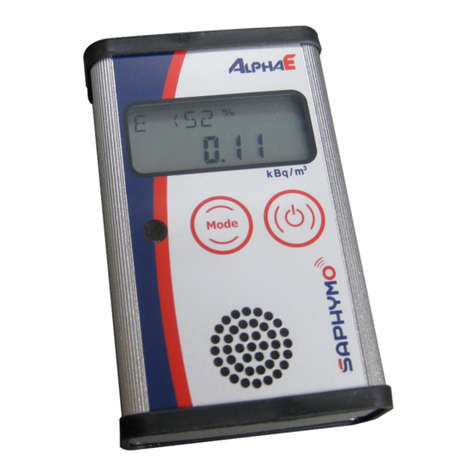
Instruction Manual for MiniTRACE CSDF
--------------------------------------------------------------------------------------------------------------------------------------------------------------------------------------------------------------------------------------------------------------------------------------------------------------------------
--------------------------------------------------------------------------------------------------------------------------------------------------------------------------------------------------------------------------------------------------------------------------------------------------------------------------
08/2012 Page 3
Figures
Figure 1: Information shown on the display .............................................................5
Figure 2: MiniTRACE CSDF display – alarm is activated ........................................6
Figure 3: Using the mode button to select an operation mode ................................8
Figure 4: Opened protective lid..............................................................................10
Figure 5: Display in dose rate mean mode ............................................................11
Figure 6: Display in cps mean mode......................................................................12
Figure 7: Measuring device for wipe tests .............................................................15
Figure 8: Wipe test measurement..........................................................................16
Figure 9: Counting up measurement .....................................................................17
Figure 10: Food measurement flow chart ................................................................18
Figure 11: Food measurement ................................................................................18
Figure 12: Display for background (control) measurement in the “Food” menu.......19
Figure 13: Result display for background (control) measurement
in the “Food” menu .................................................................................19
Figure 14: Display in the “Food” menu.....................................................................20
Figure 15: Result display in the “Food” menu..........................................................20
Figure 16: Food measurement kit (See Chapter 2.4.3.7).........................................22
Figure 17: Accessories for the wipe test (See Chapter 2.4.3.5.4)............................22
Figure 18: Belt case.................................................................................................22
Figure 19: Transparent plastic pouch ......................................................................23
Figure 20: Transportation box..................................................................................23
Figure 21: Peli Box ..................................................................................................24
Figure 22: Emergency case.....................................................................................24
Figure 23: Test source (see Chapter 2.5.1).............................................................25
Figure 24: Communication kit with MiniTRACE .......................................................25
Figure 25: Dose rate of the test source....................................................................26
Figure 26: “CMean” menu........................................................................................26
Figure 27: Side view ................................................................................................27
Figure 28: Front view ...............................................................................................27
Figure 29: Protective rubber casing.........................................................................28
Figure 30: Changing the batteries ...........................................................................30
Figure 31: Removing the grid (part 1)......................................................................30
Figure 32: Removing the grid (part 2)......................................................................31
Figure 33: Energy response of the MiniTRACE CSDF (based on Cs-137,
with lid closed and GM tube energy compensated)................................32
Figure 34: Energy response of the MiniTRACE CSDF
(with open lid, NOT energy compensated) ............................................32
Tables
Table 1: Status reports in the 5-digit alphanumeric portion of the LCD display ......5
Table 2: Overview of measurements....................................................................10
Table 3: 1-Sigma statistical uncertainty with different background dose rates .....18
Table 4: List of accessories..................................................................................21
Table 5: Technical data ........................................................................................31
Table 6: 4 π-Efficiency [Bq] MiniTRACE CSDF for different radionuclides..........33
Table 7: Calibration factors and efficiency [Bq/cm
2
] MiniTRACE CSDF
based on ISO 7503-1 .............................................................................33




























